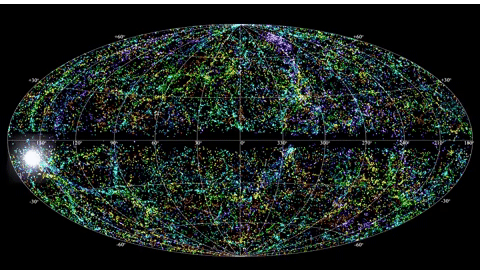Astronomers detect 25 new fast repeating radio bursts

Artist's impression of a fast radio burst traveling through space and reaching Earth. | ESO/M. Kornmesser
Fast radio bursts are one of the most powerful and mysterious astronomical phenomena. Although more than a thousand sources of these signals have been detected to date, their nature remains unknown. Astronomers from the CHIME/FRB collaboration today report the discovery of 25 new repetitive fast radio bursts. Tracking these new signals could help to finally identify the cosmic event from which they originated.
Fast radio bursts (or FRBs for fast radio bursts ) are extremely short pulses of radio waves, lasting from a few microseconds to a few milliseconds. Their discovery is relatively recent, with the very first FRB being discovered in 2007. Since then, more than 1000 sources of FRBs have been detected. These transient events are very impressive: an average FRB emits as much energy in one millisecond as the Sun in three days! Most of them are unique or repeat randomly, but a few are known to repeat at very regular intervals.
For example, the FRB 20121102 source emitted more than 200 signals between 2012 and 2017, but very erratically, while the FRB 20180916 signal repeats very exactly every 16.35 days. Most FRB detections today are made using the CHIME ( Canadian Hydrogen Intensity Mapping Experiment ) radio telescope. Inaugurated in 2017, it was initially designed to better understand the acceleration of the expansion of the Universe. Thanks to its large field of view and its wide range of frequencies (400 to 800 MHz), the installation has proven to be particularly efficient for the detection of FRBs.
A new algorithm for spotting repetitive signals
How are FRBs created? While they are presumably emitted by a source contained within an extremely strong magnetic field , their exact origin is still subject to debate. Several hypotheses have been put forward to explain these very energetic signals: rapidly rotating neutron star, black hole , merger of black holes or other compact objects, magnetar, signs of extraterrestrial communication, etc. However, none of the theories or models proposed to date can fully explain all of the properties of bursts or sources, Universe Today points out .
The objective of the CHIME/FRB collaboration is to detect and characterize as many FRBs as possible in order to reveal their origin. Each burst is indeed characterized by its position in the sky and its “dispersion measurement” (DM) – a value which describes the delay observed between the high and low frequencies composing the same burst of signals; this lag is caused by the signal's interactions with matter as it travels through space (longer wavelengths being delayed more).

In 2021, the team presented in The Astrophysical Journal the first catalog of 536 FRBs detected using CHIME, between July 2018 and July 2019; this catalog included 62 bursts from 18 previously reported repetitive sources. For their new research, the researchers used a new clustering algorithm, which can spot co-located multiple events with similar DMs.
“ The clustering algorithm takes into account all fast radio bursts detected by the CHIME telescope and searches for groups of fast radio bursts whose positions in the sky and dispersion measurements are consistent, within the limits of the measurement uncertainties. We then carry out various checks to ensure that the bursts of a group are indeed coming from the same source ,” explains Dr. Ziggy Pleunis , of the Dunlap Institute for Astronomy and Astrophysics at the University of Toronto, and member of the CHIME/FRB collaboration.
Unique bursts… which may not be
Of the more than 1,000 FRBs detected to date, only 29 had so far been identified as repetitive bursts; most repeat randomly. Using the new algorithm, the researchers spotted in the radio telescope data, collected between 2019 and 2021, no less than 25 new sources of repeating FRBs. " The new repeaters have DMs ranging from ~220 to ~1700 pcs/cm 3 , and include sources that exhibited as few as two up to twelve bursts ," they write. They also report the detection of 14 additional candidate repetitive FRBs.

Distribution in the sky of repetitive FRB sources discovered by the CHIME/FRB collaboration.
For astronomers, repetitive FRBs are obviously the best opportunity to make follow-up observations and thus identify the nature of their source with certainty. The team also noted several interesting characteristics concerning these new bursts.
To begin with, it appears that the DMs of repeated bursts are lower than those of non-repetitive sources. While this can be partly explained by observational bias (closer repeat bursts being found more easily), it may also signal a distinct astrophysical origin for repeaters versus non-repeating sources, the researchers point out.
Moreover, considering all the sources of FRB detected so far, they found that only 2.6% of the bursts are repeated. Most of the sources are also relatively inactive, emitting only a few bursts over a very long period. These long delays sometimes observed between two bursts suggest that certain FRBs considered for the moment as “unique” may not ultimately be so.
“ We cannot exclude that the sources for which we have seen only one burst so far will repeat themselves one day or another. It is possible that all sources of fast radio bursts will repeat one day, but that many sources will not be very active ,” says Pleunis. This of course implies that any theory related to the origin of radio bursts must be able to explain why some sources are much more active than others.

In hopes of finally solving this mystery, the team is encouraging radio and multi-wavelength tracking of the newly detected sources, and the other 14 candidate bursts. Future observations that will be carried out with next-generation radio telescopes — such as the Square Kilometer Array (SKAO), which should collect its first light by 2027 — will undoubtedly provide a better understanding of these mysterious signals.
Source : websites

